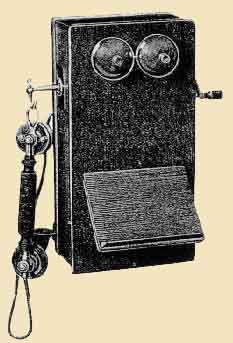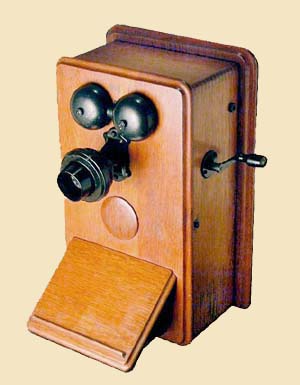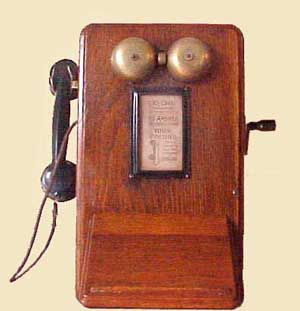British Ericsson Wall Phones
Towards the end of
the 19th century, L M Ericssons were one of the leaders in the rapidly growing
telephone industry. With the Scandinavian market approaching saturation it was
necessary to branch out into other areas. Britain was particularly attractive
because of their rapid growth and colonial interests. Their colonies relied on
the mother country for technology. Britain's telephone system was growing in a
similar style to that of Sweden. Individual towns and cities were setting up their
own exchanges and systems, and the hardware was being supplied by a range of small
companies who were still developing their expertise. Ericssons , through their
London agents, were supplying telephones and parts to the National
Telephone Company. Some National branded phones of the time are Ericsson models,
which causes confusion among collectors.
The Swedish factory was having
trouble supplying enough parts to keep up with the demand. With an eye to the
future, LME decided to set up a factory in Britain and to establish it as a joint
venture with National . This gave the company a British flavour which stood it
well in the future. The factory mass-produced telephones and components, switchboards,
and even racecourse totalizers. One particular phone from British Ericsson was
used in Australia in large numbers, their N2500 model. It gave reliable service
from the end of the First World War until the last ones were taken out of service
in the late 1980s, and many have since been refurbished and given a new life as
working antiques.
 The phone is based on the Swedish-built model AB232. This model had a side-mounted
handset, but the British-built models had a separate transmitter and receiver.
This is unusual for Ericssons, who had been producing handsets on their phones
since the 1890s. It was made necessary by the National Telephone Company, who
were using Western Electric switchboards. Their Chief Engineer maintained that
Ericsson phones would not work correctly with the WE boards. Ericsson's response
was to produce phones with the White solid-back transmitter made under license
from WE. This gave it a somewhat American style. The Beeston factory soon became
the main supplier to the U.K. and the British Empire. When the telephone companies
were consolidated under the British Post Office, it assigned contracts to the
existing manufacturers for standardised telephone equipment . Beeston received
nearly twenty percent of the contracts, far more than any other company obtained.
The phone is based on the Swedish-built model AB232. This model had a side-mounted
handset, but the British-built models had a separate transmitter and receiver.
This is unusual for Ericssons, who had been producing handsets on their phones
since the 1890s. It was made necessary by the National Telephone Company, who
were using Western Electric switchboards. Their Chief Engineer maintained that
Ericsson phones would not work correctly with the WE boards. Ericsson's response
was to produce phones with the White solid-back transmitter made under license
from WE. This gave it a somewhat American style. The Beeston factory soon became
the main supplier to the U.K. and the British Empire. When the telephone companies
were consolidated under the British Post Office, it assigned contracts to the
existing manufacturers for standardised telephone equipment . Beeston received
nearly twenty percent of the contracts, far more than any other company obtained.
The Australian Post Office was in the market for a new standard magneto
wall phone to replace the ageing Commonwealth
Ericsson, and they selected the Ericcson model. It was introduced after the
war, and supplies began to arrive in quantity in 1919-1920. It became known as
the British Ericsson. The phone went through many minor variations in its life.

The
case is a plain oak box, 240mmm X 400mm X 150mm deep. The backboard has no outside
screwholes or terminals. A pair of bells is mounted at the top of the front panel
rather than on top of the case, and a writing slope is at the bottom. Timber is
walnut or "matt polished oak" which appears to be a cellulose lacquer.
The metalwork is finished in "antique bronze", which is an oxidised
brass finish. The finish is also listed in the catalogues under other names. Transmitters
came in three models. The first was the small brass "barrel" transmitter
on a short pressed steel swivel mount (PMG type 35MW, 1916) shown at left. Phones
of this model in original condition are still surprisingly easy to find.  This was soon upgraded to the bigger solid back transmitter (PMG type 135MW, Ericsson
model N2500). The mount was changed to a simpler stamped and folded metal mount.
The change of transmitter does not appear to have been for any serious technical
reason, but more because the Solid Back transmitter was now the standard production
model. Note also the "Ericsson England" transfer. This and a Beeston
"sunburst" transfer were used for some time, but they suffered from
flaking and were usually replaced with a "Commonwealth of Australia"
nameplate whenever the phones were refurbished.
This was soon upgraded to the bigger solid back transmitter (PMG type 135MW, Ericsson
model N2500). The mount was changed to a simpler stamped and folded metal mount.
The change of transmitter does not appear to have been for any serious technical
reason, but more because the Solid Back transmitter was now the standard production
model. Note also the "Ericsson England" transfer. This and a Beeston
"sunburst" transfer were used for some time, but they suffered from
flaking and were usually replaced with a "Commonwealth of Australia"
nameplate whenever the phones were refurbished.
 A later upgrade saw the Solid Back transmitter replaced with the new bakelite
Inset transmitter. The phone shown at left, although it has the new transmitter,
has obviously been refurbished from an older model as it still has the decorative
Ericsson mount. Note also that it is in the rarer oak timber, and has a wooden
plug fitted over a dial cutout. The dial cutouts seem to have appeared early in
the range, but they were rarely used for conversions. The Australian Post Office policy
was that when a phone was replaced as part of an Automatic upgrade to the exchange,
the phones should be replaced with the current standard model. In practice this
meant a bakelite phone was usually installed. There were some conversions where
the phone was upgraded to auto and the generator retained for party line signalling.
Most phones fitted with a dial , however, are later conversions for the antique
market. The genuine conversions were given the model number 765AW.
A later upgrade saw the Solid Back transmitter replaced with the new bakelite
Inset transmitter. The phone shown at left, although it has the new transmitter,
has obviously been refurbished from an older model as it still has the decorative
Ericsson mount. Note also that it is in the rarer oak timber, and has a wooden
plug fitted over a dial cutout. The dial cutouts seem to have appeared early in
the range, but they were rarely used for conversions. The Australian Post Office policy
was that when a phone was replaced as part of an Automatic upgrade to the exchange,
the phones should be replaced with the current standard model. In practice this
meant a bakelite phone was usually installed. There were some conversions where
the phone was upgraded to auto and the generator retained for party line signalling.
Most phones fitted with a dial , however, are later conversions for the antique
market. The genuine conversions were given the model number 765AW.
By this
point most phones were being delivered or refurbished in a dark varnish. The oxidised
brass parts were simply repainted in black enamel.  In a final PMG conversion, Type 235MWH, a 300-series handset was fitted on a modified
switchhook at the side. This meant that the transmitter holes on the front panel
had to be covered with a "How to Use" notice. This example is missing
the note clip that was fitted to the writing slope.
In a final PMG conversion, Type 235MWH, a 300-series handset was fitted on a modified
switchhook at the side. This meant that the transmitter holes on the front panel
had to be covered with a "How to Use" notice. This example is missing
the note clip that was fitted to the writing slope.
Similar
styled phones have been noted from US makers, and from Sterling in the UK. The
US phones usually differ in size, being a few centimetres taller, but the Sterling
is a very close copy. Its main difference is in the shape of the corners, and
its electrical fittings. The door has more squared-off corners than the Ericsson,
and the sides are 118mm deep against the Ericsson's 113mm. The generator is a
3-bar model with cast end plates. For further details, see ATCS Newsletter January
1998.
British Ericsson phones were of a simple construction, reflecting
the styles of the times. They lacked the ornate, sometimes flamboyant European
styling. They were, however, solid and reliable. An Ericsson catalogue sets their
place in the market by stating "These instruments, although cheaper and
not so elaborate ... as the AB230 or AB535 types, are thoroughly reliable and
efficient in service". The numbers that have survived are proof of this.
 For further details on this phone
For further details on this phone
 If you have reached this page through a Search Engine, this will take you to the front page of the website If you have reached this page through a Search Engine, this will take you to the front page of the website
| 
 The phone is based on the Swedish-built model AB232. This model had a side-mounted
handset, but the British-built models had a separate transmitter and receiver.
This is unusual for Ericssons, who had been producing handsets on their phones
since the 1890s. It was made necessary by the National Telephone Company, who
were using Western Electric switchboards. Their Chief Engineer maintained that
Ericsson phones would not work correctly with the WE boards. Ericsson's response
was to produce phones with the White solid-back transmitter made under license
from WE. This gave it a somewhat American style. The Beeston factory soon became
the main supplier to the U.K. and the British Empire. When the telephone companies
were consolidated under the British Post Office, it assigned contracts to the
existing manufacturers for standardised telephone equipment . Beeston received
nearly twenty percent of the contracts, far more than any other company obtained.
The phone is based on the Swedish-built model AB232. This model had a side-mounted
handset, but the British-built models had a separate transmitter and receiver.
This is unusual for Ericssons, who had been producing handsets on their phones
since the 1890s. It was made necessary by the National Telephone Company, who
were using Western Electric switchboards. Their Chief Engineer maintained that
Ericsson phones would not work correctly with the WE boards. Ericsson's response
was to produce phones with the White solid-back transmitter made under license
from WE. This gave it a somewhat American style. The Beeston factory soon became
the main supplier to the U.K. and the British Empire. When the telephone companies
were consolidated under the British Post Office, it assigned contracts to the
existing manufacturers for standardised telephone equipment . Beeston received
nearly twenty percent of the contracts, far more than any other company obtained.

 This was soon upgraded to the bigger solid back transmitter (PMG type 135MW, Ericsson
model N2500). The mount was changed to a simpler stamped and folded metal mount.
The change of transmitter does not appear to have been for any serious technical
reason, but more because the Solid Back transmitter was now the standard production
model. Note also the "Ericsson England" transfer. This and a Beeston
"sunburst" transfer were used for some time, but they suffered from
flaking and were usually replaced with a "Commonwealth of Australia"
nameplate whenever the phones were refurbished.
This was soon upgraded to the bigger solid back transmitter (PMG type 135MW, Ericsson
model N2500). The mount was changed to a simpler stamped and folded metal mount.
The change of transmitter does not appear to have been for any serious technical
reason, but more because the Solid Back transmitter was now the standard production
model. Note also the "Ericsson England" transfer. This and a Beeston
"sunburst" transfer were used for some time, but they suffered from
flaking and were usually replaced with a "Commonwealth of Australia"
nameplate whenever the phones were refurbished.  A later upgrade saw the Solid Back transmitter replaced with the new bakelite
Inset transmitter. The phone shown at left, although it has the new transmitter,
has obviously been refurbished from an older model as it still has the decorative
Ericsson mount. Note also that it is in the rarer oak timber, and has a wooden
plug fitted over a dial cutout. The dial cutouts seem to have appeared early in
the range, but they were rarely used for conversions. The Australian Post Office policy
was that when a phone was replaced as part of an Automatic upgrade to the exchange,
the phones should be replaced with the current standard model. In practice this
meant a bakelite phone was usually installed. There were some conversions where
the phone was upgraded to auto and the generator retained for party line signalling.
Most phones fitted with a dial , however, are later conversions for the antique
market. The genuine conversions were given the model number 765AW.
A later upgrade saw the Solid Back transmitter replaced with the new bakelite
Inset transmitter. The phone shown at left, although it has the new transmitter,
has obviously been refurbished from an older model as it still has the decorative
Ericsson mount. Note also that it is in the rarer oak timber, and has a wooden
plug fitted over a dial cutout. The dial cutouts seem to have appeared early in
the range, but they were rarely used for conversions. The Australian Post Office policy
was that when a phone was replaced as part of an Automatic upgrade to the exchange,
the phones should be replaced with the current standard model. In practice this
meant a bakelite phone was usually installed. There were some conversions where
the phone was upgraded to auto and the generator retained for party line signalling.
Most phones fitted with a dial , however, are later conversions for the antique
market. The genuine conversions were given the model number 765AW. In a final PMG conversion, Type 235MWH, a 300-series handset was fitted on a modified
switchhook at the side. This meant that the transmitter holes on the front panel
had to be covered with a "How to Use" notice. This example is missing
the note clip that was fitted to the writing slope.
In a final PMG conversion, Type 235MWH, a 300-series handset was fitted on a modified
switchhook at the side. This meant that the transmitter holes on the front panel
had to be covered with a "How to Use" notice. This example is missing
the note clip that was fitted to the writing slope.